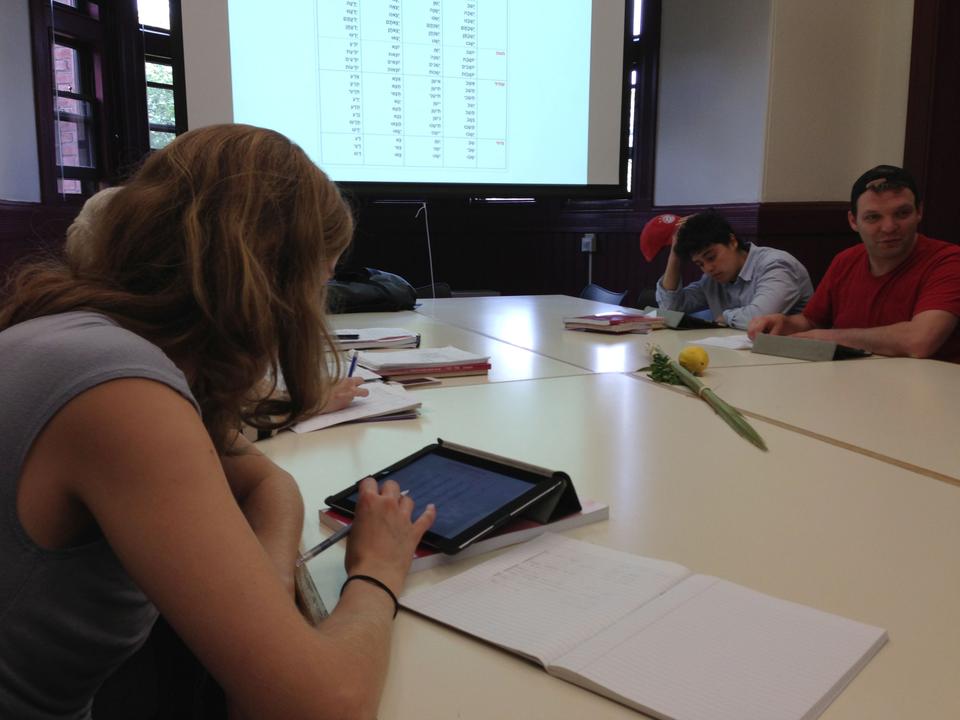
News
Cambridge Residents Slam Council Proposal to Delay Bike Lane Construction

News
‘Gender-Affirming Slay Fest’: Harvard College QSA Hosts Annual Queer Prom

News
‘Not Being Nerds’: Harvard Students Dance to Tinashe at Yardfest

News
Wrongful Death Trial Against CAMHS Employee Over 2015 Student Suicide To Begin Tuesday

News
Cornel West, Harvard Affiliates Call for University to Divest from ‘Israeli Apartheid’ at Rally
Hebrew Class Uses iPads For Teaching, Learning

In this fall’s Modern Hebrew 120a: “Intermediate Modern Hebrew” course, digital apps and iPads have replaced paper flash cards and textbooks. In collaboration with Harvard’s Academic Technology Group, Irit Aharony, the head of Harvard’s Modern Hebrew Studies Program, has created a digital textbook on iBooks for use in her second-year language class.
Some of the functions on the digital textbook include interactive exercises and vocabulary flashcards, as well as stories in Hebrew that students can read as they listen along to the audio recording.
According to Aharony, Intermediate Modern Hebrew is the only class at Harvard that exclusively uses a digital textbook via iPad. To equip students for access to their coursework, Harvard has loaned iPads to all nine students in the class. Students use the iPad for both homework assignments and in-class activities.
Elette C. Boyle, a graduate student at MIT who cross-registered for the class, said this is her first time using an iPad.
“It took me a little while to get used to the iPad, but it’s a great tool that I can take anywhere, like a coffee shop,” Boyle said. “I also get immediate feedback on my work.”
Aharony said the idea of integrating technology in her classroom emerged last year when she saw students who were simultaneously talking on their phones and flipping paper flashcards on their way to class.
As she watched them pass by, Aharony said she remembered thinking, “Why do they need both tools? Why not combine them?”
The desire to allow her students to use the study material on their devices, coupled with the need to go greener, prompted Aharony to make the switch first to an online flashcard program and ultimately to a digital textbook on iPad.
Incorporating new technology, however, has presented some challenges as well. Osnat Aharoni, the teaching assistant for the course, said that the specific nature of Hebrew has presented unique technical problems. The application has to grapple with two languages read in opposite directions—Hebrew from right to left, and English from left to right—and a system of diacritical marks.
“It creates an extra ten-fold level of difficulty for the technical team,” Aharoni said, crediting Kevin Guiney and Bill Barthelmy from the Academic Technology Group for all their hard work.
Eventually, Aharony said she hopes to use animation for her study materials.
“Having animations pop out as students read in Hebrew—that’s my fantasy,” she said. “For now, we are learning as we go along and improving how we can better present the work for the students.”
Aharoni added that the students in the class, who range from undergraduates to graduate students from MIT and Harvard, have become as much a part of the development team as the teachers and the IT team.
“They are helping to debug the program throughout the course,” she said.
Aharony, who is in her 40th year of teaching, said the education scene has changed completely since she came to Harvard in 1996. Back then, Aharony recalls having to make copies of tapes so that her students can listen to Israeli music and individually calling them when she needed to make an announcement after class. Now, everything is posted immediately on the course iSite.
“Technology has changed everything,” she said “It changed life.”
Yet, Aharony said that one thing remains constant. “The students are still very involved in the language and eager to learn,” she said. “That certainly hasn’t changed.”
—Staff writer Jane Seo can be reached at janeseo@college.harvard.edu
Want to keep up with breaking news? Subscribe to our email newsletter.
